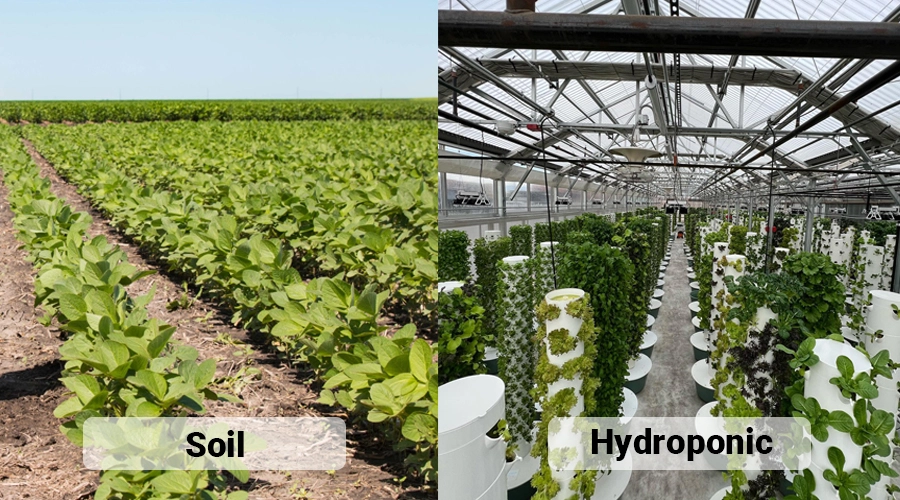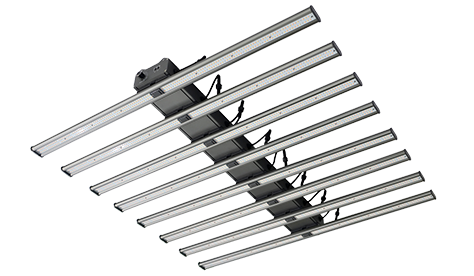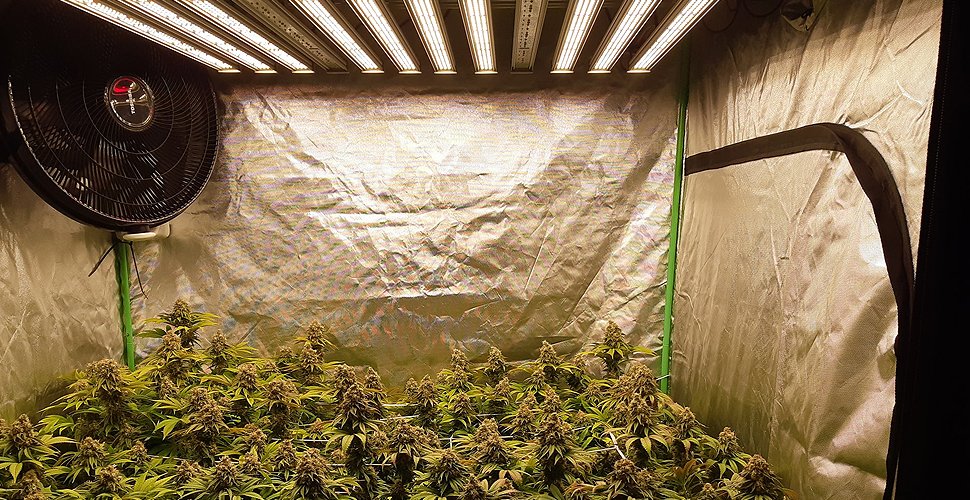Wissen Sie, wie das Gemüse und Obst, das wir täglich essen, angebaut wird? Ist es durch traditionelle Landwirtschaft oder Hydrokultur?
- Traditionelle LandwirtschaftMit einer jahrtausendealten Geschichte ist es derzeit die weltweit am weitesten verbreitete landwirtschaftliche Methode.
- Bei der in den letzten Jahrzehnten entwickelten Hydrokultur handelt es sich um den Anbau von Pflanzen in einer Umgebung ohne Erde.
Was sind die Unterschiede zwischen traditioneller Landwirtschaft und Hydrokultur? Welches ist für die Zukunft der landwirtschaftlichen Entwicklung besser geeignet? Lassen Sie uns diese Fragen untersuchen.
Wie unterscheidet sich die Hydrokultur von der traditionellen Landwirtschaft?
Wachstumsmedium
Traditionelle Landwirtschaft: Der Boden dient in der traditionellen Landwirtschaft als Wachstumsmedium und bietet Pflanzen Unterstützung.
Hydroponik: Hydroponik macht Erde überflüssig und nutzt Nährlösungen, um Pflanzen mit Nährstoffen zu versorgen. Zur Unterstützung der Pflanzenwurzeln können verschiedene Stützmaterialien wie Perlit, Vermiculit und Schaumstoff verwendet werden.
Wassernutzung
Traditionelle Landwirtschaft: Die Bewässerung von Nutzpflanzen in der traditionellen Landwirtschaft beruht auf natürlichen und künstlichen Niederschlägen. Wasser kann durch Verdunstung und Infiltration verloren gehen.
Hydrokultur: Wasser in der Hydrokultur kann durch Prozesse wie Verdunstung, Infiltration und Transpiration rezirkuliert werden.
Ertrag
Traditionelle Landwirtschaft: Das Pflanzenwachstum in der traditionellen Landwirtschaft wird von den Boden- und Klimabedingungen beeinflusst, was im Allgemeinen zu geringeren Erträgen führt.
Hydrokultur: Hydrokultur kann Pflanzen reichlich mit Wasser und Nährstoffen versorgen und so potenziell die Ernteerträge steigern.
Umweltauswirkungen
Traditionelle Landwirtschaft: Der Einsatz von Pestiziden und Düngemitteln in der traditionellen Landwirtschaft kann zu Boden- und Wasserverschmutzung führen.
Hydrokultur: Hydrokultursysteme basieren oft hauptsächlich auf Nährlösungen, wodurch der Einsatz von Düngemitteln reduziert wird.
Kosten
Traditionelle Landwirtschaft: Die traditionelle Landwirtschaft ist tendenziell kostengünstiger, da sie keine Nährlösungen und keine zusätzliche Ausrüstung erfordert.
Hydrokultur: Hydrokultur ist aufgrund der Anfangsinvestitionen in Nährlösungen und Ausrüstung teurer als die traditionelle Landwirtschaft.
Anwendbarkeit
Traditionelle Landwirtschaft: Die traditionelle Landwirtschaft erfordert Landressourcen im Freien.
Hydroponik: Hydroponik kann an verschiedene Innen- und Außenumgebungen angepasst werden, darunter städtische Gebiete, Wüsten und andere schwierige Bedingungen.
Warum ist Hydrokultur besser als traditionelle Landwirtschaft?
Herausforderungen der traditionellen Landwirtschaft
Hoher Ressourcenverbrauch. Die traditionelle Landwirtschaft benötigt erhebliche Wasserressourcen für die Bewässerung und einen erheblichen Einsatz von Düngemitteln, um die Erträge zu steigern. Der übermäßige Verbrauch dieser Ressourcen kann negative Auswirkungen auf die Umwelt haben.
Probleme der Bodendegradation. Der Einsatz von Pestiziden und Düngemitteln in der traditionellen Landwirtschaft kann die Bodenstruktur zerstören. Längerer und übermäßiger Anbau kann zu einem Rückgang der Bodenfruchtbarkeit führen und sogar zur Wüstenbildung beitragen.
Abhängigkeit vom natürlichen Wetter. Die traditionelle Landwirtschaft ist bei Produktion und Ernte stark von den Wetterbedingungen abhängig. Wetterbedingte Katastrophen wie Überschwemmungen, Dürren, Taifune usw. können zu verringerten Ernteerträgen oder sogar zu völligen Ernteausfällen führen
Analyse der Nachhaltigkeit moderner Landwirtschaft: Hydrokultur vs. traditionelle Landwirtschaft
Reduzierter Wasserverbrauch. Hydroponik kann den Wasserverbrauch im Vergleich zum herkömmlichen Anbau deutlich um bis zu 90 % senken. Dies wird durch eine präzise Überwachung des Wasserverbrauchs und der internen Wasserzirkulation im System erreicht, wodurch Verschwendung und Verdunstung minimiert werden.
Erhöhte Erträge. Pflanzen in Hydrokultursystemen weisen häufig schnellere Wachstumsraten und höhere Erträge pro Flächeneinheit auf. Dies liegt daran, dass die Wurzeln direkten Zugang zu genau kontrollierten Nährstofflösungen haben, wodurch Konkurrenz und Einschränkungen durch die Bodenbedingungen entfallen.
Geringerer Landbedarf. Hydroponische Systeme können in Innenräumen betrieben werden und ermöglichen eine vertikale Stapelung, wodurch sie sich gut für städtische Gebiete oder Regionen mit begrenzter Landverfügbarkeit eignen.
Klimakontrolle. Kontrollierte Umgebungen wie Gewächshäuser ermöglichen eine ganzjährige Produktion unabhängig von den Wetterbedingungen. Dadurch werden Ernteverluste aufgrund von Faktoren wie Frost oder Schädlingsbefall minimiert.
Arbeitsreduzierung. Automatisierung und Technologie in Hydrokultursystemen können Prozesse rationalisieren und den Bedarf an manueller Arbeit im Vergleich zur traditionellen Landwirtschaft deutlich reduzieren.
Erfolgreiche Fallstudien zur hydroponischen Landwirtschaft

China: JD Hydroponische Gemüsefabrik
Die JD Hydroponic Gemüsefabrik befindet sich in Zhejiang, China. Diese im Jahr 2018 gegründete Hydrokulturfarm nutzt fortschrittliche Hydrokulturtechniken. Die Anlage baut verschiedene Gemüsesorten an, darunter Salat, Tomaten, Gurken und Paprika.
Vereinigte Staaten: AeroFarms
AeroFarms ist eine vertikale Hydrokulturfarm mit Sitz in Newark, New Jersey, USA. Der 2011 gegründete Bauernhof baut eine Reihe von Gemüsesorten an, darunter Salat, Tomaten, Gurken und Paprika.


Niederlande: Tomatoworld
Tomatoworld widmet sich dem Anbau von Tomaten mithilfe fortschrittlicher Hydrokultur und nachhaltiger Landwirtschaftstechniken. Es ist ein Bildungszentrum, das Besuchern aus der ganzen Welt die neuesten Innovationen in der Gewächshaustechnologie, einschließlich Hydrokultur, vorstellt.
Wenn Sie sich für hydroponische Indoor-Landwirtschaft oder den Anbau in kleinen Gewächshäusern interessieren, erkunden Sie bitte unsere Vertikale Gartensysteme für den Innenbereich. Wir bieten kompakte Fabrikpflanzmaschinen für simulierte Pflanzen und können vertikale Systeme an Ihre Anforderungen anpassen.
Wird Hydrokultur die traditionelle Landwirtschaft ersetzen?
Viele Menschen fragen sich vielleicht, ob die Hydrokultur der Zukunftstrend ist. Ich glaube, dass die hydroponische Landwirtschaft Vorteile hat, aber ohne bestimmte Bedingungen und Zeitaufwand kann sie die traditionelle Landwirtschaft nicht vollständig ersetzen.
Während wir die Vorteile der hydroponischen Landwirtschaft angesprochen haben, hat sie auch einige Nachteile:
Hohe Kosten. Die anfänglichen Investitionskosten für die hydroponische Landwirtschaft sind relativ hoch, was für Kleinbauern eine Herausforderung darstellt.
Hohe technische Anforderungen. Die hydroponische Landwirtschaft erfordert ein hohes Maß an technischem Fachwissen und erfordert Fachwissen und Erfahrung.
Begrenzte Anwendbarkeit. Derzeit eignet sich die hydroponische Landwirtschaft vor allem für Kleinkulturen. Es besteht die Hoffnung, dass Fortschritte in der Hydrokulturtechnologie zu Durchbrüchen beim Anbau größerer Nutzpflanzen führen werden.
Unter Berücksichtigung der oben genannten Faktoren glaube ich, dass der zukünftige Trend für die hydroponische Landwirtschaft wie folgt aussieht:
In bestimmten Regionen und Sektoren wird die hydroponische Landwirtschaft Vorteile erlangen und die traditionelle Landwirtschaft nach und nach ersetzen. Beispiele hierfür sind Trockengebiete, städtische Zentren und High-End-Märkte.
Die hydroponische Landwirtschaft wird sich in die traditionelle Landwirtschaft integrieren und eine neue Art der landwirtschaftlichen Produktion bilden. Durch die Integration der Hydrokulturtechnologie in die traditionelle Landwirtschaft können Erträge gesteigert, Ressourcen geschont und die Umweltbelastung verringert werden.
Jayes
Als Digital Marketing Manager bei AUXGROW vereint Jayes eine Leidenschaft für Hydrokultursysteme mit Fachwissen für LED-Wachstumslampen. Mit praktischer Erfahrung und einem tiefen Verständnis führt Jayes Sie durch die Welt des nachhaltigen Anbaus.






